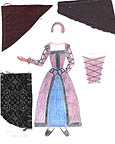
Alicia's gown sketch
The gown that I designed as my "perfect gown" would have been worn in France most likely during the late 1540s and the 1550s. The pictures that I used for inspiration were primarily Margaret de Valois and Francoise Breze, Duchesse de Buillon, both by Francois Clouet. I also considered Portrait of Charlotte of France by Jean Clouet.
I have chosen to make this dress out of a purple-brown linen trimmed in black. I chose the purple-brown linen partly because I already have 10 yards of it that I have been sitting on for several years. I think this color is similar to the "French russet" color used in the 1500s. I have chosen to accent the dress with black because it is difficult to find fabric that goes with this purple-brown color and I think black guards, piping, and other embellishments will look most attractive on the final product. Right now I am planning to make the kirtle out of cotton fabric that is close to "watchet". I haven't purchased this fabric yet but it was the only fabric that I could find that was not completely synthetic in a color that was even remotely of the correct period.
I chose linens and cottons for this gown because I want something that breathes well. This is a gown that I may wear for entire weekends during moderately cool to very warm times of the season and I want to make sure that I can survive on the warm days.
The accessories I chose are very simple. A coif and a caul will be worn on the head. Gloves will be optional and used when needed for protection from the elements. The shoes are black "pumps" with moderate pinking. To complete the outfit, a simple long beaded necklace will be worn around the neck.
The underpinnings for this costume include a shift with loose sleeves and a square neckline, a bumroll, a corset, and a Spanish farthingale. Over these underpinnings, this costume will have a sleeveless kirtle and the outer gown. The outer gown has two pieces to it; a detachable tabbed bodice and a skirt. The bodice has guards that extend down and around the bottom edge of the skirt. The epaulets on the shoulders are pinked with cording around the edges. The tabs at the waist are also corded. The sleeves are tied to the bodice at the bodice armhole. They are split and decorated with beads and couching. The shoes are like modern espidrils and the gloves are decorated with lacing at the wrists. The coif will be decorated with beadwork, couching, and possibly slashing, but the exact design has not been decided on.
I am planning to draft this pattern myself using directions and drafting tips from the class and the internet. I decided to draft the pattern myself because the pre-made patterns that I have used in the past never turn out as well as I hope them to. I also find the challenge of drafting my own pattern pieces to be very exciting.
I decided to use this particular style of gown because I feel that my level of sewing will allow me draft the pattern from scratch and still come out with a decent final product. Once I master this, I will go on to design and draft a pattern for the V-necked Italian style bodice that was popular in the i 570s.
Budget influenced my design and fabric choices immensely. Since I am using fabric that I already have, it will allow me to spend a little more money on embellishments than I would if I had to go out and buy the fabric at the same time.
I will be wearing this gown primarily at Renaissance Faires throughout the Spring, Summer, and Fall seasons. It may need to be won for the entire weekend 3-4 times per month. I will be doing a lot of walking and some sifting. This influenced my design a lot too because I wanted something that would be comfortable to wear in cool, warm, and hot weather. I also wanted a style of gown that I could easily play up or down depending on how fancy I wanted to be that weekend and how hot the weather was. I feel that with detachable sleeves and optional gloves and accessories, I will be able to do this easily without getting to far away from the period.
The other factor that influenced me in this gown's design was my desire to try making certain items that I've never made before. For instance, I have never made headwear until taking this class, and while looking at the research links from the class site, I found the coif and caul directions to look fun and challenging, and I think the final product is something I would like on my own head. I have also never done much embellishing and wanted to design a gown with moderate embellishments that would be challenging but not overwhelm me.